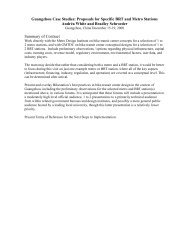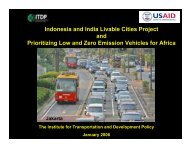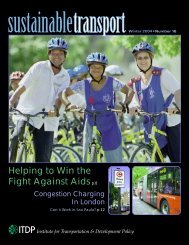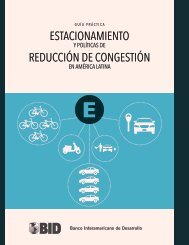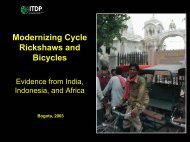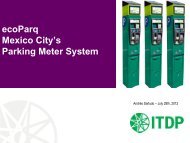Bike Sharing Sweeps Paris Off Its Feet - ITDP | Institute for ...
Bike Sharing Sweeps Paris Off Its Feet - ITDP | Institute for ...
Bike Sharing Sweeps Paris Off Its Feet - ITDP | Institute for ...
Create successful ePaper yourself
Turn your PDF publications into a flip-book with our unique Google optimized e-Paper software.
Letter From the Executive Director<br />
Image: CEPT University, Ahmedabad<br />
continued from p. <br />
Well-tailored solutions, like the planned Ahmedabad BRT system<br />
seen above, are needed <strong>for</strong> our city streets.<br />
graveyard, otherwise it will be overcrowded. If there are<br />
cyclists, they need to be incorporated into the design, or<br />
bikes will just ride down the busway like they do in Curitiba<br />
and Mexico City.<br />
I, too, have been guilty of thinking “by the numbers,”<br />
using ideological frameworks as a shortcut to the hard work<br />
of detailed case-specific analysis. <strong>ITDP</strong> used to fight with<br />
the World Bank about subsidies to transit passengers. Transit<br />
subsidies were justified, we argued, because motorists do not<br />
pay the full social cost of their trip. Then we discovered BRT.<br />
Because the best BRT systems were so profitable and seemed<br />
to solve the problem of operating subsidies, we believed that<br />
in all cases BRT systems could make transit operations selffinancing.<br />
BRT systems designed from inception to be profitable are<br />
more likely to focus on congested, high demand corridors<br />
where they are most needed. Particularly in cities with a<br />
history of publicly-subsidized bus operations, like in India,<br />
China, and South Africa, some BRT systems are being developed<br />
with little concern about profitability. Subsidies end up<br />
being used more to avoid tough political decisions than to<br />
keep fares low. Too often BRT systems end up needing subsidies<br />
because they are badly designed or built on wide roads<br />
at the urban periphery where there is little ridership and no<br />
congestion.<br />
In our projects, from Ahmedabad, Johannesburg, Dar es<br />
Salaam, Mexico City, to Guangzhou, we always try to design<br />
the systems to not require operating subsidies. It is the best<br />
way to ensure that BRT systems are sustainable in the long<br />
run and get built where they benefit the most people.<br />
Recently, however, even TransMilenio has found it hard<br />
to maintain high quality service as the system expands to<br />
less lucrative routes, so long as parking and road use is subsidized.<br />
We are working with the help of the Clinton Climate<br />
Initiative to help them solve these problems, but carefully<br />
structured subsidies may be in the cards. Ahmedabad<br />
has very low cost competition from shared three-wheelers<br />
and motorcycles. Dar es Salaam has very low incomes.<br />
Johannesburg has long trip distances and low population<br />
density. In these conditions, cities face tough decisions about<br />
what parts of the system to subsidize, where to set the level of<br />
service, how clean and com<strong>for</strong>table the buses should be. One<br />
size does not fit all. Carefully tailored business plans embedded<br />
in carefully written contracts that create incentives <strong>for</strong><br />
high per<strong>for</strong>mance are what is needed, not rigid policies that<br />
inhibit optimal solutions.<br />
Today, thanks to the ef<strong>for</strong>ts of <strong>ITDP</strong>, the Energy<br />
Foundation, and other partners, many Chinese mayors<br />
are learning to be better tailors, looking to Bogotá, <strong>Paris</strong>,<br />
London, and Seoul <strong>for</strong> inspiration. Guangzhou is set to build<br />
a state of the art BRT system that is carefully crafted to<br />
Guangzhou’s needs, while reintroducing bike lanes and bike<br />
parking facilities.<br />
The best transportation solutions are rarely clearly ‘left’<br />
or ‘right’. In Latin America, leaders of the Mexican left<br />
(Obrador) and the Chilean left (Lagos) famously built<br />
blighting urban highways, ostensibly to generate jobs, even<br />
though they did little to benefit the poor. Today, Mexico<br />
City’s left-oriented Mayor Ebrard, from the same left political<br />
group, is proving to be a leader of the sustainable transport<br />
movement, cycling to work himself, initiating a big<br />
expansion of their bike and BRT networks, while megahighway<br />
projects are rarely mentioned. In Bogotá, the ‘left’<br />
candidate is campaigning against the world’s most famous<br />
BRT system in favor of a metro system that would cost hundreds<br />
of millions of dollars to improve travel <strong>for</strong> a few rich<br />
neighborhoods.<br />
Sadly, in the United States too, our national leaders are<br />
still giving us solutions by the numbers. US Democratic<br />
congressional committees have tried to obstruct congestion<br />
charging and market-based transport programs, while the<br />
US Secretary of Transportation does not even recognize<br />
bicycling as transportation. We are also witnessing the costly<br />
results of a US <strong>for</strong>eign policy conducted ‘by the numbers’.<br />
The world needs a politics of tailor-made solutions based<br />
on analysis of specific problems and tough negotiation in the<br />
public’s interest, not policies that assume the private sector,<br />
or the public sector, is always right. Mayors are emerging as<br />
some of the world’s best tailors. The <strong>Paris</strong> Vélib bike sharing<br />
program, London and Stockholm’s congestion charging<br />
systems, Bogotá’s TransMilenio BRT system, were all made<br />
possible by a fundamental yet subtle renegotiation of the<br />
relationship between the government and the private sector.<br />
Clever governments and clever companies figured out new<br />
ways of making money that reduced the burden on taxpayers<br />
while providing a higher quality public service and a secure<br />
investment environment <strong>for</strong> the private sector. In the ef<strong>for</strong>ts<br />
of these great local leaders, who struggle daily to improve the<br />
everyday lives of their constituents, lay the seeds of a profound<br />
political trans<strong>for</strong>mation.<br />
Sustainable Transport /Fall 2007





